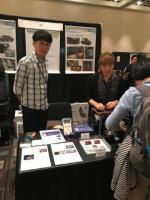Forums:
Dear Members,
I was in a second-hand bookshop in Edinburgh just recently and I came across a copy of "Selected Scientific Works of Hans Christian Oersted". (Translated and edited by Karen Jelved, Andrew D. Jackson and Ole Knudsen, Princeton University Press, 1997.) After only a quick flick through it I was able to judge that the marked price of 15GBP (approximately 21USD) represented an absolute bargain, and along with an illustrated copy of Kenneth Grahame's "The Wind in the Willows", I snapped it up there and then.
I already knew that not only had Oersted shown a great deal of interest in Thomas Johann Seebeck's earliest reports of what came to be known as the Thermoelectric Effect, but also that he was instrumental in the accurate interpretation of what this effect was.
Oersted had been conducting his own experiments observing the deflections of compass needles in the vicinity of a current-carrying electric circuit, but he had only ever used electrolytic (Voltaic) piles as the source of the electrical potential for his circuits. However, because the effect that Seebeck had demonstrated by the application of only a temperature difference to his bi-metallic circuits appeared identical to that observed by Oersted, it appears that it was in fact Oersted who first correctly deduced that the deflection of the needle produced by Seebeck's experiments was also the result of an electrical current being induced in his circuits.
This was Oersted's reaction to the discovery, which he published in the paper, "On Some New Experiments in Thermoelectricity Performed by Baron Fourier and Mr Oersted", in 1823:
"I have had the honor of demonstrating to this illustrious assembly the remarkable experiments by which Mr Seebeck has proved that an electric current may be produced in a circuit formed of solid conductors only by disturbing the equilibrium of the temperature. We are therefore in possession of a new class of electric circuits, which may be called thermoelectric circuits, thus distinguishing them from galvanic circuits, which from now on may conveniently be called hydroelectric."
Well, the term "hydroelectric circuit", which Oersted had proposed for distinguishing those circuits relying on electrolysis for their source of electrical potential, obviously did not catch on, but I think that here was Oersted's own assertion of the fundamental principle that a thermoelectric circuit is capable of producing an electrical current without any electrolysis being involved.
In an earlier paper, "New Experiments by Dr. Seebeck on Electromagnetic Effects", also 1823, Oersted stated:
"Dr. Seebeck has also succeeded in producing a thermelectric (sic) current in a single metal, but this succeeded only with metals that have a quite perceptible crystalline texture so that the various parts of a crystal then seem to play the role of different metals."
I wonder if this may have been the first ever recognition of the fact that the thermoelectric effect is much more pronounced in a material which has an inhomogeneous internal structure.
And it may also be interesting to note that the first use of dental amalgam, which is a highly inhomogeneous metallic material when compared with pure metals or with any true alloy of metals, is credited to the French dentist Auguste Taveau at around the same period.
Finally, at least for now, it appears that by 1830 either Seebeck or Oersted had succeeding in confirming that a thermoelectric circuit was capable of exciting neurological activity in a dissected frog's leg:
"It is very remarkable that, notwithstanding all that has been mentioned, the thermo-electric circuit makes a prepared frog's leg palpitate, like the hydro-electrical circuit. The communication between the extremities of the circuit and the nerves of the frog were made by means of platina wire, in order to guard against the influence of unequally oxidated surfaces." (Well who would have thought of that?! - KPW)
This last quote is taken from Oersted's paper, "Thermo-electricity", of 1830. Unfortunately he does not mention the level of temperature differential that was required to produce the palpitation's in the frog's leg - although since he would have been using a thermoelectric circuit constructed of more than one metal, presumably it would have been significantly less than that from the "boiling water" that Volta had needed to apply to one end of his single-metal rod when he did it (see http://bookbootusers.co.uk/Anat_P2.pdf).
Maybe there's still a PhD in it for some gifted experimental thermoelectrician who's curious enough to find out.
Best regards,
Keith P Walsh
PS, Don't worry about "The Wind in the Willows" by the way. It's just make-believe.





















































































































Some Questions?
Ok, I appreciate that I didn't pose any direct questions in my last post, so let's have a quick recap and see what we can come up with.
It might be best to start with the frog’s legs experiments that Galvani and Volta had carried out a couple of decades or so before Seebeck and Oersted.
Galvani first observed convulsions in frog’s legs when he connected their ends with bi-metallic “arcs”, but his early experiments never cited the influence of any temperature differential. However, when Volta became involved he found that he could get a single homogeneous metal arc to produce the convulsions if he immersed one end of it in boiling water first before connecting it across the frog’s leg. (See: http://bookbootusers.co.uk/Anat_P2.pdf)
It is Volta’s description of this experiment which has led professor Anatychuk of the Institute of Thermoelectricity in the Ukraine to successfully establish that it was in fact Volta who was the first scientist to identify a purely “thermoelectric” effect.
It has long been appreciated that the thermoelectric effect is much more pronounced when there are dissimilar conductors in contact with each other, and this may well explain why neither Galvani nor Volta had recognised the influence of temperature differential in their earlier experiments which used only bi-metallic arcs.
This point can be illustrated by considering the basic representation of the frog’s leg experiment at:
http://www.bookbootusers.co.uk/frogsleg.htm
Anyone familiar with the thermoelectric effect will recognise that if the arc is held by hand hand at the centre where the two metals are joined in contact with each other, and the frog’s leg has been chilled in order to preserve it, then a thermoelectric potential must exist across the frog’s leg. And if potentials of this order are sufficient to produce the muscular convulsions (remember we have already reasoned that it should be significantly less than that of a homogeneous arc which has had one end immersed in boiling water), then this would explain why Galvani and Volta were initially unaware of any thermoelectric effect being present.
Of course, some people still argue that the bi-metallic arc and frog’s leg must become involved in an electrolytic reaction in order for the leg to start jumping (for example see: http://www.bookbootusers.co.uk/letter-05.htm), and this is where the importance of Oersted’s contribution comes in. To re-quote Oersted:
"It is very remarkable that, notwithstanding all that has been mentioned, the thermo-electric circuit makes a prepared frog's leg palpitate, like the hydro-electrical circuit. The communication between the extremities of the circuit and the nerves of the frog were made by means of platina wire, in order to guard against the influence of unequally oxidated surfaces."
You see, Oersted knew that it was necessary to isolate the metal parts of the circuit from any chemical interaction with the frog’s leg in order to eliminate any electrolytic effect by introducing a metal which does not oxidise. If you look again at the frog’s leg diagram, and imagine that short lengths of platinum wire (Oersted wrote “platina”) are interposed at the tips of the copper and iron components of the arc, then any excitation of the frog’s leg MUST be the result of a purely thermoelectric effect.
The frustrating thing of course is that the translation of Oersted’s paper neglects to state what level of temperature differential was required in order to initiate the convulsions in the Oersted/Seebeck’ experiments. (Although, as we have already said, we should expect it to have been significantly less than 100’C.)
Oersted also reported Seebeck as having detected a thermoelectric response in an unspecified metallic material of inhomogeneous composition, which may or may not have been dental amalgam. Here’s the quote again:
"Dr. Seebeck has also succeeded in producing a thermelectric (sic) current in a single metal, but this succeeded only with metals that have a quite perceptible crystalline texture so that the various parts of a crystal then seem to play the role of different metals."
Once again we are frustratingly denied the details of how great the measured effect was, or what level of temperature differential was required to produce it, but I think that anyone reading these accounts should now be able to recognise the pertinence of questions such as the following:
1) What is the minimum temperature differential that must be applied across a single thermoelectric junction in order for it to excite neurological function in animal tissue?
2) What are the largest thermoelectric potentials that can be produced by inhomogeneous metallic materials when subjected to only ordinary temperature differentials?
3) Are the thermoelectric potentials generated by metal amalgam dental fillings large enough to dissipate electrical energy through the nerves in people’s heads?
And, in view of the fact that metal amalgam dental fillings continue to be placed in children’s teeth, I think that it is also most pertinent to ask why it appears that there isn’t anyone anywhere in the world who knows what the thermoelectric properties of a typical dental amalgam are.
Does anyone disagree?
Keith P Walsh
Some Scientific Reasoning
Still no takers? Ok, let's do the "who's being scientific and who isn't" thing again.
It appears that non-scientists can be easily persuaded to accept that the fact that dental amalgams have been used for almost two hundred years somehow "proves" that there cannot be anything wrong with them; and that if there was something wrong with them then it would be obvious to everyone that this was so.
However, once you understand that it also appears that there isn't anyone anywhere in the world who knows what the thermoelectric properties of a typical dental amalgam are, then anyone with a greater faculty for scientific reasoning should recognise that it is perfectly possible that neither of these presumptions is true.
The explanation is as follows.
The widespread adoption of metal amalgams for use in restorative dentistry was quickly followed by the rise to prominence of psychiatric "medicine" in our societies; and for a scientist, the fact that nothing at all is known about the thermoelectric behaviour of amalgam dental fillings could easily explain why the relationship of cause and effect between these two developments has never been recognized.
You see, there aren't any muscles in the upper and lower mandibles where amalgam fillings are placed, so, unlike in the Oersted/Seebeck frog's leg experiments, their thermoelectric potentials are not able to cause any muscular spasms there. However, there are some very sensitive organs nearby, such as the ears and the eyes (not to mention the brain). And, as we now fully appreciate, each person’s internal perception of the outside world is gained entirely by small electrical impulses transmitted through the nerves from the sense-organs to the brain. So, if it were true that the thermoelectric potentials generated by amalgam dental fillings are able to dissipate electrical energy through people's heads, then a scientist should not be surprised if people who had them in their teeth were to complain of neurological disorders such as "noises in their ears", "funny feelings in their heads", "feelings of paranoia", "inability to relax properly", "lack of self-esteem", etc..
Do any of these sound familiar to anyone? Well, I believe that they would have sounded familiar to 19th century psychiatrists. However, I am not so sure if any of them would ever have read Hans Christian Oersted's description of Thomas Johann Seebeck's experiment where he discovered that an inhomogeneous metallic material displays a much more significant thermoelectric effect than that of a pure (or homogeneous) metal acting at an equivalent temperature differential. (Remember that dental amalgam is a highly inhomogeneous mixture of metals.)
In order to appreciate the importance of these things, it is necessary to understand that the psychiatric profession doesn't actually know whether the common so-called "psychiatric disorders" are the result of thermoelectric effects acting in metal dental fillings or not. And it can even be argued that the psychiatric profession does not in fact have any explanation for such disorders at all. Names such as "schizophrenia" and "manic depression" are simply that; names to describe patterns of behavior which are problematical for the individuals who display them and for the societies that they inhabit. These names are useful in identifying common types of behavior and developing the best means of managing them, but they do not explain why these problematic behaviors arise in the first place.
To illustrate this point, it appears that non-scientists can be easily persuaded to accept that a statement such as "this person is suffering from schizophrenia" fully explains the cause of the problem, whereas, in fact, only a statement such as "this person is suffering from a disturbance to their natural neurological function arising from the thermoelectric activity in their dental fillings, and this is causing them to display the pattern of behavior which we call schizophrenia", would offer an explanation of the actual cause of the problem, should the stated cause actually prove to be correct.
In attempts to identify the actual causes of the so-called "psychiatric disorders" mentioned above, millions of dollars have been spent in recent years on research to try and find a link between their occurrence and the genetic make-up of those diagnosed as suffering from them (so far without success). I presume that this is because it is felt in some quarters that the explanation must be "genetic" (or "just natural") and that it can be demonstrated that psychiatric disorders are an inevitable consequence of the presence of certain genes.
However, at the same time it appears that nothing has ever been spent on research to investigate the thermoelectric behavior of metallic dental restorations. Nothing at all. Not ever.
We have all grown up in societies where a significant proportion of individuals have thermoelectric batteries in their teeth. And I think that some of us may have been too easily persuaded to accept that the behaviors that these individuals display are "just natural". However, it should be clear to anyone with the ability to reason scientifically that if we are all completely ignorant of the thermoelectric behavior of dental amalgams, then this might not be the case.
Some dental associations continue to insist that any health problems caused by amalgam dental fillings must be too insignificant to worry about. I would suggest that if the thermoelectric potentials generated by amalgam fillings are large enough to dissipate electrical energy through the nerves in people's heads, then the use of metal amalgams in restorative dentistry may actually prove to have been the greatest technological blunder that the human race has ever inflicted upon itself, and rather than being too small to worry about, the problem is actually too big for most of us to recognise.
Metal amalgam dental fillings are placed in children's teeth. I believe that the thermoelectric behavior of amalgam fillings should therefore have been scientifically investigated, and that their thermoelectric properties should be known.
Is there anyone out there scientific enough to agree with me?
Kind regards,
Keith P Walsh
PS, I've planned for this thread to include four posting from myself. The next one will again give my definition of what I call the "pro-ignorance argument" which, for anyone who would like to read it now, can be found via Google. The next post will also describe how dishonest and unscientific some “scientists” are.
Do The Science
Ok, so, what we need to do is look again at the diagram of the frog's leg experiment:
http://www.bookbootusers.co.uk/frogsleg.htm
In his paper of 1830 Hans Christian Oersted stated that:
"The communication between the extremities of the circuit and the nerves of the frog were made by means of platina wire, in order to guard against the influence of unequally oxidated surfaces".
Oersted, and presumably Seebeck, knew that if lengths of a non-corroding metal conductor were interposed between the two dissimilar conductors (in our example, copper and iron) and the extremities of the frog's leg, then the presence of any electrolytic effect would be eliminated, and the cause of the palpitations would be purely thermoelectric.
And for thermoelectric scientists, the question now arises as to how large a temperature differential would have been required to produce the observed palpitations in the frog's leg. Unfortunately we are not told this, but we might be able to deduce a ball-park estimate from our knowledge of experiments done by others.
It appears that Professor L I Anatychuck of the Institute of Thermoelectricity in the Ukraine has successfully established that it was in fact Alessandro Volta who first accurately described a thermoelectric effect in the 1790s, again regarding an experiment with a frog's leg. Volta succeeded in producing palpitations in the leg using an arc of only a single metal (iron), by first immersing one end of it in boiling water before connecting it across the frog's leg, see "ON THE DISCOVERY OF THERMOELECTRICITY BY VOLTA":
http://bookbootusers.co.uk/Anat_P2.pdf
So that sets the bar for a SINGLE conductor at around one hundred degrees Celsius (minus room temperature perhaps at the unheated end) for a SINGLE metal conductor.
Now, thermoelectric scientists will be aware that thermoelectric phenomena involving dissimilar metals in contact with each other are an order of magnitude greater than those involving only single metals. And, conversely, the temperature differential required across a bi-metallic circuit is an order of magnitude LESS than that required across a single metal in producing an equivalent thermoelectric potential.
So this gives us a feel for the temperature difference which Oersted and/or Seebeck would have needed to apply to their circuit comprising dissimilar metals in order to produce palpitations in the frog's leg by a purely thermoelectric effect - perhaps only a few degrees Celsius. Oersted described the phenomenon thus:
"It is very remarkable that, notwithstanding all that has been mentioned, the thermo-electric circuit makes a prepared frog's leg palpitate."
It sounds like Oersted himself may well have been surprised at just how small a temperature difference was required to produce the effect, and perhaps if we were to repeat these experiments then we too may be similarly surprised too.
Volta, and his contemporary Luigi Galvani, had also done lots of experiments causing frog's legs to jump using bi-metallic arcs, but in their descriptions of these experiments they never once cited the role of temperature difference in producing the effect. It would appear therefore that any thermoelectric potential acting in their circuits had been produced by temperature differentials that they were not even mindful of.
I still think that Oersted's description of how Seebeck had detected thermoelectric effect acting in a "single" material, which he knew to be of inhomogeneous composition, is very interesting:
"Dr Seebeck has also succeeded in producing a thermelectric (sic) current in a single metal, but this succeeded only with metals that have a quite perceptible crystalline texture so that the various parts of a crystal then seem to play the role of different metals."
This also raises further questions.
Would the instruments used by Seebeck to make his measurements in 1820s have been more sensitive than the nerves in animal tissue?
What size of temperature differential would be required to detect thermoelectric activity in a material comprising an inhomogeneous mixture of dissimilar metals?
What is the largest thermoelectric potential that can be produced in a metal amalgam dental filling acting at only ordinary temperature differentials?
Are the thermoelectric potential generated by metal amalgam dental fillings large enough to dissipate electrical energy through the nerves in people's heads?
I think it's about time we did the science to find out.
Keith P Walsh
Amalgam Phased Out In Norway
In his report “Review of Norwegian experiences with the phase-out of dental amalgam use”, John M Skjelvik states the following with regard to the use of dental amalgams in Norway:
“From this review of the experiences from the phase-out of the use of amalgam as tooth filling material in Norway the following conclusions are presented:
Use and release of mercury are substantially reduced
The estimated use of mercury in tooth fillings has been considerably reduced over the years. Early sources indicate that the use of mercury in new tooth fillings was as high as 2 000 kg in 1985. In 1995 the use of mercury in new tooth fillings was 840 kg, and was then gradually reduced close to zero in 2008 when the general use was banned (Klif 2010a, 2010c).”
I would expect that Norwegian medical records might indicate if there is (or isn’t) any corresponding reduction of the incidence of so-called “mental illness” in Norway.
As with most assessments of the potential health impact of dental amalgam, the Skjelvik report restricts any discussion regarding “cause and effect” exclusively to the toxic properties of the mercury contained in amalgam fillings. However, in a later section, the following truth is acknowledged:
“In Life Science Research Office (LSRO, 2004) the results of a comprehensive review of scientific studies of these issues are presented. The report concludes that there is little evidence to support a causal relationship between mercury fillings and human health problems. The authors note, however, that many research gaps existed, which, if addressed, may settle the dental amalgam controversy once and for all.”
And of course, one such glaring “research gap” is that there doesn’t appear to be anyone anywhere in the world who knows what the thermoelectric behavior of a typical dental amalgam is; because it also appears that the experimental research studies which would be necessary in order to find out have never been conducted.
Perhaps the best way to appreciate this dilemma is by considering the following two statements:
a) There is no scientific evidence to suggest that the thermoelectric potentials generated by amalgam dental fillings are able to dissipate electrical energy through the nerves in people’s heads.
b) There is no scientific evidence to suggest that the thermoelectric potentials generated by amalgam dental fillings are not able to dissipate electrical energy through the nerves in people’s heads.
Scientists will recognise that if the experimental studies required in order to make a proper scientific judgement on this matter have never been carried out, then each of these statements may accurately be regarded as all of the following:
(1) Perfectly correct.
(2) Perfectly consistent with the other
(3) Completely meaningless.
My prediction is that, with the advancement of neurological scanning instruments, it will become increasingly difficult to remain ignorant of whether or not neurological function in the vicinity of teeth with amalgam fillings is any different from that in the vicinity of teeth without them. And if there is any correlation between the incidence of so-called “psychiatric disorders” and the phasing out of amalgam in certain countries, then the causal explanation will be found.
In conclusion, Oersted’s book includes a statement which is not about the study of thermoelectricity specifically, but about scientific endeavour in general. He describes the work of Johann Wilhelm Ritter, a contemporary of Oersted’s, who had done pioneering work in electromagnetism but had postulated some related theories which had later been shown by experiment to be incorrect. I think that what follows is a valuable observation on the relationship between theorists and the verification of their ideas by experimental scientists:
“We are far from patronizing a vain exhibition of new ideas, by which it is possible for a very ordinary mind to make pretensions to every new discovery; but when works are stamped with the true stamp of genius, it is but justice to acknowledge the merits of their speculations. Some writers have thought that this act of justice would deprive experimental philosophers of a part of the honour due to their exertions; but this honour is quite unimpaired, if the author, who has anticipated their discoveries, has only had a vague and obscure notion of them; while it must be avowed, that when the author has clearly announced the discovery, has derived it from good data and conceived its connections with other truths, the merit of the experimental philosopher is only that of having confirmed it by experiment, which still in many cases can be a work of no smaller claim to glory than the primitive conception itself.”
Best regards,
Keith P Walsh
Anecdotal Evidence and The Principle of Cause and Effect
I wrote to John Magne Skjelvik, author of “Review of Norwegian experiences with the phase-out of dental amalgam use”, via his LinkedIn account as follows:
-----
Dear Mr Skjelvik,
With regard to your report “Review of Norwegian experiences with the phase-out of dental amalgam use”, I envisage that with the phasing-out of dental amalgam in Norway, Sweden and Denmark a corresponding reduction in the incidence of many so-called psychiatric illness will have been noticed; but also that the pro-amalgam lobby will not allow this to be publicised on the grounds that the authorities in these countries do not have a scientifically proven explanation linking the two phenomena by the relationship of cause and effect.
I think that it would therefore be particularly unfortunate if dental patients in other countries continue to suffer because those who believe that such a link exists have failed to identify the correct explanation for it. It is known that inhomogeneous mixtures of dissimilar metals generate significantly higher levels of thermoelectric potential than either pure metals or true alloys. However, and in spite of the fact that amalgam fillings are placed in children's teeth, it appears that no-one knows what the thermoelectric properties of a typical dental amalgam are; and this is because it also appears that experimental studies to measure these properties have never been carried out.
I find this an unjustifiable omission from our scientific understanding of the electrical behaviour of amalgam dental fillings. If you are interested in finding out more about this issue then please read the article "Enquiries Concerning The Electrical Properties of Dental Amalgams", which can be found on my website at: http://www.bookbootusers.co.uk/intro.htm
I would be grateful to hear any opinion you may have on this.
Best regards,
Keith Walsh
-----
To date I have not received a reply.
If it were to be demonstrated that the phasing-out of dental amalgam in Norway, Sweden and Denmark has corresponded with a reduction in the incidence of so-called “psychiatric illnesses” in all three countries, then this might be considered compelling evidence that the two things are linked. However, it appears that some so-called “scientists” continue to insist that before banning amalgam in all countries it should be necessary to explain this link according to the principle of cause and effect.
This is not correct. There are well-known instances where anecdotal evidence alone has been sufficient to justify the removal of the sources of harm to populations without any detailed scientific explanation linking the effect with the cause having been found. The science of epidemiology itself is considered to have been founded by investigations into the Broad Street cholera outbreak of 1854. Close the water pump and people stop being infected; open it up again and they start being infected again. So close it for good until the water is no longer contaminated. The anecdotal evidence is all that’s required to identify the cause and put an end to the effect.
Similarly, in the late 1950s a sedative drug called thalidomide was found to cause deformities in babies when taken by pregnant women. Here again, prescribe the drug and deformities occur; stop prescribing it and they stop occurring. No scientific explanation other than the anecdotal evidence is required in determining the necessary course of action. Of course, you can imagine that some pharmaceutical chemist sat in his room somewhere muttering to himself, “No-one ever proved it was thalidomide.”, but he would have been wrong. There comes a point when the anecdotal evidence is so strong that the insistence on taking no action before a full explanation of the link between cause and effect is established passes from the realm of scientific principle to become nothing better than rank stupidity.
Nevertheless, with the case of dental amalgam we have reasoned that, in the absence of any scientific evidence to the contrary, the link between amalgam fillings and many so-called psychiatric illnesses could easily be explained by the thermoelectric behaviour of the fillings having an adverse effect on neurological function. It has been suggested that the electrical potentials generated by amalgam dental fillings are able to dissipate electrical energy through the nerves in people's heads and, in so doing, make people unhappy. And if it is established that the populations of Norway, Sweden and Denmark have become generally happier in recent years, then this could easily be due to the fact that there are no longer large proportions of these populations walking around with thermoelectric batteries (amalgam fillings) in their teeth.
The meaning of the word “anecdotal” is not “false”, “inaccurate” or “unscientific”. The true meaning of this word is “incomplete” or “unexplained”. As such, anecdotal evidence often provides an indicator of something important which is not yet recognised, and true scientists have a duty not to ignore anecdotal evidence, but to examine it for the possibility of gaining a deeper scientific understanding. And in the case of dental amalgam, it seems clear that the thermoelectric behaviour of this material should be investigated – something which has apparently never been done.
Does anyone know if there are any thermoelectric scientists in Norway, Sweden or Denmark?
Keith P Walsh
keith.p.walsh@btinternet.com
Powerful Jealousies
I’ve been wondering, does anyone know if the Norwegian mass murderer Anders Breivik had thermoelectric batteries (amalgam fillings) in his teeth?
Certainly some people would suggest that he suffered from “psychiatric illness”.
Try Googling “keith.p.walsh” with “powerful jealousies”.
But remember, some people do become terribly abusive when confronted by their own ignorance, and of course that's completely unscientific.
Best regards,
Keith P Walsh
The Experts
I googled “norway thermoelectric science”, and discovered a project called the Basic and Applied ThermoElectrics (BATE) initiative, which currently operates in the Department of Physics at the University of Oslo. The project team consists of several highly qualified scientists with an impressive range of research experience in the fields of thermoelectric materials and thermoelectric phenomena.
If it is the case that the phasing out of dental amalgam (a significantly inhomogeneous mixture of dissimilar metals) has coincided with a reduction in the incidence of so-called psychiatric disorders in Norway, then it might be an idea to ask this group of scientist whether or not the thermoelectric behaviour of dental amalgams could provide the explanation for linking the two by the relationship of cause and effect.
Of course, they might conclude that the thermoelectric potentials generated by amalgam fillings are not large enough to dissipate electrical energy through the nerves in people’s heads. But they would have to have carried out some experimental investigations in order to demonstrate this first, wouldn’t they?
The web page of the BATE initiative can be found at:
http://www.mn.uio.no/fysikk/english/research/projects/bate/index.html
The names and email addresses of the most significant contributors are listed below.
Professor Clas Persson: clas.persson@fys.uio.no
Professor Truls Norby: truls.norby@kjemi.uio.no
Professor Anette Eleonora Gunnæs: a.e.gunnas@fys.uio.no
Professor Terje Finstad: terje.finstad@fys.uio.no
Ole Bjørn Karlsen (Senior Engineer): o.b.karlsen@fys.uio.no
Professor Vidar Hansen: vidar.hansen@fys.uio.no
Professor Ole Martin Løvvik: o.m.lovvik@fys.uio.no
Professor Johan Taftø: johan.tafto@fys.uio.no
Professor Bjørn Hauback: bjorn.hauback@fys.uio.no
Professor Randi Haakenaasen: randi.haakenaasen@fys.uio.no
Xin Song (Postdoctoral Fellow): xins@fys.uio.no
Kristian Berland (Postdoctoral Fellow): kristian.berland@smn.uio.no
Professor Reidar Haugsrud: reidar.haugsrud@smn.uio.no
Matthias Schrade (Postdoctoral Fellow) : matthias.schrade@smn.uio.no
A happy New Year to all.
Keith P Walsh
The Importance of Measurement in Science
I am indebted to Professor Safa Kasap of the Department of Electrical Engineering at the University of Saskatchewan in Canada for the following quote by William Thomson, later Lord Kelvin, 1824-1907.
“I often say that when you can measure what you are speaking about, and express it in numbers, you know something about it; but when you cannot measure it, when you cannot express it in numbers, your knowledge is of a meagre and unsatisfactory kind.”
In spite of the fact that amalgam dental fillings are placed in children's teeth, it appears that no-one has ever attempted to measure the thermoelectric properties of a typical dental amalgam.
Not anyone.
Ever.
According to Thomson, we should therefore expect our knowledge on the matter to be of a meagre and unsatisfactory kind.
Does anyone disagree?
Keith P Walsh